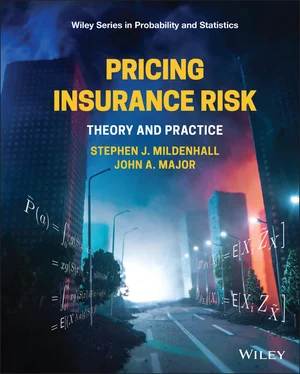Stephen J. Mildenhall - Pricing Insurance Risk
Здесь есть возможность читать онлайн «Stephen J. Mildenhall - Pricing Insurance Risk» — ознакомительный отрывок электронной книги совершенно бесплатно, а после прочтения отрывка купить полную версию. В некоторых случаях можно слушать аудио, скачать через торрент в формате fb2 и присутствует краткое содержание. Жанр: unrecognised, на английском языке. Описание произведения, (предисловие) а так же отзывы посетителей доступны на портале библиотеки ЛибКат.
- Название:Pricing Insurance Risk
- Автор:
- Жанр:
- Год:неизвестен
- ISBN:нет данных
- Рейтинг книги:4 / 5. Голосов: 1
-
Избранное:Добавить в избранное
- Отзывы:
-
Ваша оценка:
- 80
- 1
- 2
- 3
- 4
- 5
Pricing Insurance Risk: краткое содержание, описание и аннотация
Предлагаем к чтению аннотацию, описание, краткое содержание или предисловие (зависит от того, что написал сам автор книги «Pricing Insurance Risk»). Если вы не нашли необходимую информацию о книге — напишите в комментариях, мы постараемся отыскать её.
A comprehensive framework for measuring, valuing, and managing risk Pricing Insurance Risk: Theory and Practice
Pricing Insurance Risk: Theory and Practice
Pricing Insurance Risk — читать онлайн ознакомительный отрывок
Ниже представлен текст книги, разбитый по страницам. Система сохранения места последней прочитанной страницы, позволяет с удобством читать онлайн бесплатно книгу «Pricing Insurance Risk», без необходимости каждый раз заново искать на чём Вы остановились. Поставьте закладку, и сможете в любой момент перейти на страницу, на которой закончили чтение.
Интервал:
Закладка:
We implemented the Case Studies using Fast Fourier Transforms (FFTs) because they are fast and precise. You do not have to worry about simulation errors or wait for simulations to complete. The FFT method is described in Wang (1998a) and Mildenhall (2005). FFT methods are extremely powerful but have a fatal flaw: they assume all marginal distributions are independent. For our examples, this flaw is irrelevant. Although the Case Studies assume independent marginals for convenience, all of the methods and algorithms still apply when the marginals are not independent. Its flaw makes FFTs unsuitable for most production applications, and we know that most readers do not use FFTs. Remember: you can implement the Case Studies in any programming language or simulation tool. Just be aware that your answers will vary from those we show due to simulation errors.
2.5 Learning Objectives
1 Describe the cash flows in a one-period Ins Co.
2 Implement the Discrete Example in a spreadsheet to replicate numerical computations.
3 Program the Case Studies and replicate the numerical computations.
3 Risk and Risk Measures
In this chapter, we define and classify risk. We explain different ways to use a random variable to represent a risky outcome. We introduce the Lee diagram and use it to represent expected loss, limited loss, and excess loss. We define a risk measure and explain how it codifies a risk preference. Finally, we characterize risk measures, discuss their applications in pricing and capital management, and consider their potential functional forms.
3.1 Risk in Everyday Life
Every day, we take action, sometimes without being sure of the outcome. Some actions result from decisions we make, while others are inescapable. Some uncertain outcomes are well-defined such as with a lottery ticket or card game, but most are ill-defined: What kind of career would I have with a bachelor’s degree in statistics? What will my retirement be like with this amount of savings? Some are purely monetary, others related to health, family, politics, or world events. Bernstein (1996) summarizes how the modern world emerged, in part, because we developed better ways to understand and decide between actions with uncertain outcomes.
Our risk preferences have economically meaningful consequences. A decision depends on the riskiness of the outcome and the risk attitude of the decision maker (Diamond and Stiglitz 1973). When we act on our own behalf we are free to choose how to act; when we act as an agent we are required to act in a manner consistent with certain standards of behavior. There is substantial interest in decision theory: making consistent and considered choices between alternative courses of action with uncertain outcomes. Decision theory is a fundamental part of economics, finance, management, risk theory, and actuarial science.
Quantitative decision theory relies on numerical risk measures. A risk-based capital formula and an insurance pricing model are two examples of numerical risk measures. The definition, specification, and classification of risk measures is a central problem of actuarial science, with a long history (Borch 1962; Bühlmann 1970; Goovaerts, De Vylder and Haezendonck 1984).
3.2 Defining Risk
The International Organization for Standardization (ISO) Guide 73:2009 defines riskto be the effect of uncertainty on objectives, where an effectis a deviation from what is expected. Risk is caused by eventswhich have consequences. The pivotal word in the definition is uncertainty, which ISO defines as “the state, even partial, of deficiency of information related to, understanding or knowledge of, an event, its consequence, or likelihood.”
We use the ISO definition of risk. Insurers also use the riskto refer to the peril (earthquake, fire, flood, etc.) that may cause a loss and use a riskas a synonym for an account, case, insured, contract or policy, or for the subject of a policy.
There is a fundamental distinction between speculative risk and pure risk. A pure riskor insurance riskhas a potential bad outcome but no good outcomes. It is a possible loss with no chance of gain. Insurance policies are designed to put the insured, at best, in the same position they would have been without a loss (in order to avoid morale hazard). A speculative riskor asset riskhas both good and bad outcomes; it can be a loss or a gain. Reframing can convert a pure risk into a speculative one. The loss on an insurance policy is a pure risk. But the net position, premium less loss and expense, is a speculative risk.
An uncertain outcome that involves a choice is called a prospect. A prospect is relative to a reference point. The uncertainty in your bonus is relative to what you expect, not zero. Business is evaluated relative to plan, not insolvency. This can make the distinction between pure and speculative risks a matter of definition; an insurer can focus on the policy loss payments (pure risk) or on the net position of premium less losses (speculative risk). The existence of different reference points can also lead to framing bias problems, described in Kahneman (2011).
A prospect with outcomes denominated in a monetary unit is called a financial risk. An insurance loss, the future value of a stock or bond, and the present value of future lifetime earnings are examples of financial risks.
A financial risk can have timinguncertainty, amountuncertainty, or both. It can involve:
Payment of a known amount at a random time, e.g. benefit payment on a whole or term life insurance policy.
Payment of a random amount at a known time, e.g. payment on a pure endowment policy, which pays if the insured survives to a certain age or payment of a year-end employee bonus if the employer profit target is met.
Payment of a random amount at a random future time, e.g. loss payment on a typical property-casualty insurance policy.
Insurance contracts can reduce timing or amount uncertainty, or both, for example by specifying payment dates or applying limits and deductibles to loss amounts. Accounting rules often require that reinsurance contracts transfer both timing and amount risk.
Risk is time separableif a measure of the magnitude of the risk of an amount at a future time can be expressed as the product of (1) the magnitude of the risk of the amount if immediately due, times (2) a discount factor. In this book we will assume risk is time separable. Under time separability a risk measure becomes a measure of amount risk. (Timing risk and discounting are discussed in Chapter 8.)
3.3 Taxonomies of Risk
In this section, we describe different ways to classify risk. Here, we are talking about classifying generic types of risk in the abstract, not about classifying insureds in the sense of rating class plans. It is generally not productive to dwell excessively on abstract risk classifications, but it is useful to be aware of them and to establish a common vocabulary.
The US Risk Based Capital framework for Property/Casualty insurers classifies risks into the following categories Obersteadt (2017):
R0: Asset risk—subsidiary insurers
R1: Asset risk—fixed income
R2: Asset risk—equity
R3: Credit risk
R4: Underwriting risk—reserves
R5: Underwriting risk—premium
RCAT: Catastrophe risk (earthquake and hurricane).
The European Solvency II Standard Formula for the Solvency Capital Requirement classifies risks as:
Читать дальшеИнтервал:
Закладка:
Похожие книги на «Pricing Insurance Risk»
Представляем Вашему вниманию похожие книги на «Pricing Insurance Risk» списком для выбора. Мы отобрали схожую по названию и смыслу литературу в надежде предоставить читателям больше вариантов отыскать новые, интересные, ещё непрочитанные произведения.
Обсуждение, отзывы о книге «Pricing Insurance Risk» и просто собственные мнения читателей. Оставьте ваши комментарии, напишите, что Вы думаете о произведении, его смысле или главных героях. Укажите что конкретно понравилось, а что нет, и почему Вы так считаете.












